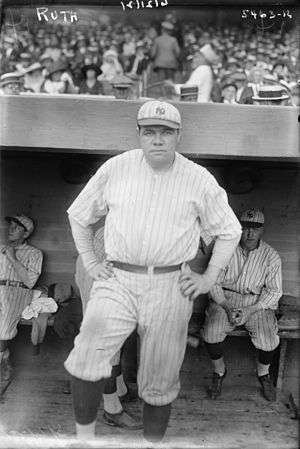Golden age of baseball
The Golden Age of Baseball, or Baseball's Golden Era, is the period from about 1920 to 1960.[1] The golden era is the time period immediately following the dead-ball era (before World War I) but prior to what is now called the modern era. There is no exact timeframe in any of these eras.[2] MLB considers the post World War II era to be the beginning of the modern age, which places the golden era between the end of World War I and the end of World War II.
Much of baseball's golden age was captured in black and white film, adding to the mystique and folklore of the game. The first baseball game broadcast in color was in 1951,[3] and by the mid-1960s all baseball games were broadcast in color, which could be viewed as the end of the golden age.

Players
The golden age was dominated by stars such as Lou Gehrig, Jackie Robinson, Ty Cobb, Ted Williams, Hank Greenberg, Rogers Hornsby and especially Babe Ruth, whose called shot was one of the defining moments of the era. Another defining moment of the golden era was Gabby Hartnett's Homer in the Gloamin'. By 1919, when Ruth hit a then-league record 29 home runs, a spectacular feat at that time, the dead-ball era had officially come to an end, ushering in the Live-ball era. While the most popular icons of the golden era are hitters, and Ruth is generally thought of as one of the premier sports icons in history,[4] there were also several pitchers who dominated hitters on the mound during that same time, and two of the best of them were Lefty Grove and Dizzy Dean, both of whom won over 30 games in the early 1930s. Later in the era, players such as Willie Mays, Mickey Mantle, Ernie Banks, and pitchers Bob Gibson and Warren Spahn, among others, established themselves as Hall of Famers and ultimately played into the late 1960s and 1970s, providing a bridge between the current era and the golden age.
Teams
From a team perspective, the golden age of baseball (using the years 1918-1964 as a guideline) was dominated by the American League's New York Yankees,[5] who won 29 pennants and 20 World Series titles between 1918 and 1964.[6] To expound on that figure, in the National League, it took three clubs combined to win 27 pennants (nine each) during that same timeframe, those teams being the St. Louis Cardinals, Brooklyn Dodgers and New York Giants, all of whom were dominant in their own right. In addition, the N.L.'s Chicago Cubs tallied 6 N.L. pennants (none until 2016) and the A.L.'s Detroit Tigers snared four A.L. pennants during that same time, the second highest total in the junior circuit after the Bronx Bombers' historic 29.
Teams travelled primarily by train during the period, occasionally stopping off at saloons and speakeasies in between games, mingling with fans and adding to the mystique of the era, as this is unlikely to happen often today. Many players also worked other "primary" jobs in the offseason, and others stepped away in the middle of their careers to serve in the military. Entire franchises were worth hundreds of thousands of dollars, at the time, with the Cleveland Indians becoming the first team to be sold for over $1,000,000 when Bob Hope and Bill Veeck bought the club for $1.6 million.[7]
See also
- American League Pennant Winners 1901-68
- National League Pennant Winners 1901-68
- Damn Yankees
- 1918–1964
- Baseball color line
- Roger Maris
References
- ↑ The DVD series Baseball's Golden Age defines the period as 1920 until 1960.http://www.imdb.com/title/tt1263818/
- ↑ http://msn.foxsports.com/other/story/8261514/FSN-revisits-
- ↑ http://thelongestlistofthelongeststuffatthelongestdomainnameatlonglast.com/first274.html
- ↑ "Babe Ruth: Biography from Answers.com". Answers.com. Retrieved 2008-10-22.
- ↑ http://www.baseball-reference.com/
- ↑ http://www.newyorkyankees.com/
- ↑ Schneider, Russell (2001). Cleveland Indians Encyclopedia. Sports Publishing LLC. pp. 56, 346. ISBN 1-58261-376-1.